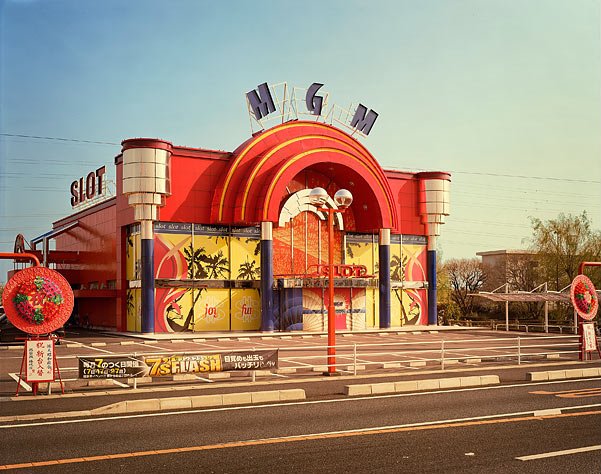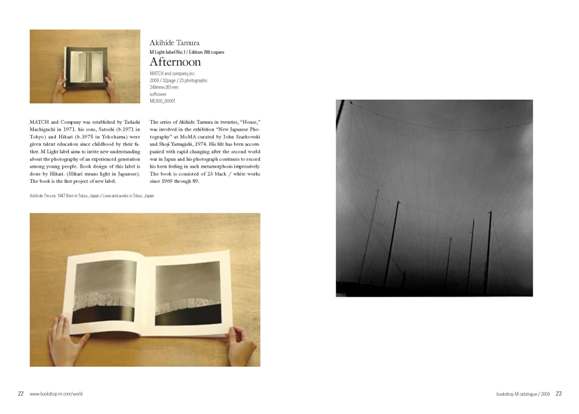Eyecurious is following the current trend and will be hibernating from now until early January. It has been a great first year of blogging and am looking forward to even better things next year. Wishing everyone out there a Joyeux Noël and a Bonne Année and hoping that you get all the photo-related gifts that your hearts desire. See you in 2010.
Review: Steven B. Smith, The Weather and a Place to Live

I wrote about Steven B Smith's series, The Weather and a Place to Live, in passing recently, but I've now got my hands on a copy of the book, which won the Center for Documentary Studies / Honickman First Book Prize in Photography in 2005, and have had the chance to have a more in-depth look.
The series focuses on the "American West", one of the great photographic subjects of both the nineteenth and twentieth centuries. The "American West"... for some reason the name itself sounds epic. Tackling this subject is no small undertaking, particularly given those that have done so in the past. Smith is clearly indebted to the New Topographics, the group of landscape photographers that featured in George Eastman House's seminal 1975 exhibition (Note: the show has been restaged this year and is currently traveling around the US before coming to Europe. I have just got a copy of the catalogue, so expect a review of this in the coming weeks).
The parallels with the New Topographics are obvious, but Smith's approach feels very much his own. He has focused in on one specific aspect of these landscapes, which is the mechanics of the steadily expanding suburban sprawl. Suburbia is being built at a furious pace and in many of these photographs it feels as if the dust has not yet had the time to settle.
Smith is not photographing a finished landscape, but one that is in rapid flux. This reminded me of Ryuji Miyamoto's concept of "temporary ruins" that he used to refer to the buildings that he photographed around Japan as they were being destroyed, only to be replaced almost instantly by a new structure of some kind (the series Architectural Apocalypse). Toshio Shibata's work on the complex infrastructure of Japan's roads occupies a similar space. His images also deal with a changing landscape, where extraordinary feats of engineering attempt to find some harmonious coexistence with nature.
The thing that I found differentiated Smith's work from these other series, and much of landscape photography in fact, is the emotional range of his images. This kind of work normally operates in a deadly serious register, oscillating between the beautiful and the ordinary, but almost always without emotion. I found that Smith's images treaded slightly different ground: they evoke fear, amazement, even sadness, but also a healthy does of humour at the ridiculousness of these manufactured landscapes.
Ridiculous is a word that kept coming to mind with these images. The ridiculousness of suburbia slowly taking over an area that is almost a universal symbol for wilderness: the American West. The ridiculousness of trying to trim and tame a landscape this wild and this epic in scale. Smith shows all of this with great subtlety and a wry sense of observation: there are few showy images here.
One thing I struggled with a bit in some of this work is the light. Smith sometimes shoots in very bright sunlight, which I imagine is typical weather for many of these locations, and so some of these images are almost bleached out, which I found distracting. Although this spoiled a couple of individual images for me, it does contribute to evoking the atmosphere of the place. And speaking of place, a special mention should go to the title of this series. As readers of eyecurious will know, titles have never been my forte, so I'm always impressed (jealous) when a title can encapsulate as much as this.
In some ways I felt that the first image of the book (below) could have been the last. It has the look and feel of a graveyard and suggests just how quickly the suburban landscapes that are being built here may fall into ruin.
The Weather and a Place to Live: Photographs of the Suburban West (Durham: Duke University Press, 2005, 128 pages, 80 duotone plates).
Rating: Recommended
Guido Castagnoli
 Guido Castagnoli's images of small Japanese towns focus on familiar territory: there is other similar work floating around (Takashi Homma's work on suburban Tokyo stands out from the crowd), but the originality of Castagnoli's images is the light. These scenes of empty parking lots, amusement parks and all-but-abandoned main streets, tend to be shot in colder, more bleached-out tones. Castagnoli's images have a sun-drenched warmth that I haven't seen elsewhere. If provincial Japan was in 1970s California...
Guido Castagnoli's images of small Japanese towns focus on familiar territory: there is other similar work floating around (Takashi Homma's work on suburban Tokyo stands out from the crowd), but the originality of Castagnoli's images is the light. These scenes of empty parking lots, amusement parks and all-but-abandoned main streets, tend to be shot in colder, more bleached-out tones. Castagnoli's images have a sun-drenched warmth that I haven't seen elsewhere. If provincial Japan was in 1970s California...
Some things I bought this year
I've seen quite a few end of year lists popping up over the last week. There are the best books of 2009 lists, the more eclectic lists of "stuff I liked this year", the lists of books acquired in 2009 and many more. I think you need to be a breakfast-lunch-and-dinner kind of consumer of photo-books to post a best books of 2009 list and having just discovered a great many fantastic-looking ones through the future of photo-books discussion, I am not going to stick my neck out on that one. Instead in order to jump onto the list-mania bandwagon, I am going to go with a list of a few of the photo items that I bought in 2009 (these weren't necessarily made in 2009). Looking back over the year, I think this is an interesting way of seeing trends in the things that you gravitate to and also seeing how much money you wasted on things that you spend no time with at all.
Some photographic things that I bought in 2009
(Note: I am in a fortunate position where a number of books that come into my possession I don't actually have to pay for, so there are a number of terrific books that I discovered this year that won't make it on to this list)
Anders Petersen & J.H. Engström, From Back Home (Bokförlaget Max Ström, 2009)

This won the Author Book Award at Arles 2009. I posted a review a while back.
Akihide Tamura, Afternoon (M Light label No.1, 2009)

Although I just got this and have already posted about it, I get the feeling this is one that I will keep coming back to.
Ryuji Miyamoto, Cardboard Houses (signed, Bearlin, 2003)

Beierle + Keijser's "Becher box": Jogurtbecher

I have already spent the best part of an evening with E deciding what images we are going to use in our Jogurtbecher grid. And I actually hate yoghurt.
Michio Yamauchi, Stadt (Sokyu-sha, 1992)

Naoya Hatakeyama, A Bird (Taka Ishii, 2006)

OK I cheated, I didn't actually buy this, but this is probably the book that I have gone back to most frequently this year so it had to be included. Check out Jeff Ladd's review here to get an idea why.
Ikko Narahara, Pocket Tokyo (Creo, 1997)

Eikoh Hosoe, A Butterfly Dream (signed, Seigensha, 2006)

The extragavance of the year. This book was produced as a companion to the first edition of Kamaitachi. Hosoe presented it to Kazuo Ohno for his 100th birthday, shortly before his death. (As Michael rightly pointed out, Ohno is still around!)
J Wesley Brown
J Wesley Brown is a fan of the night and of the solitary figure. I was less convinced by his portraits, some of which felt a little too staged for my liking, but I enjoyed the atmosphere of his nighttime images of urban or suburban landscapes. They have a strange sense of abandonment and unease, as if all human beings had just mysteriously vanished. They made me think of Gregory Crewdson if he hung around a bit more after dark, but I guess that Wesley Brown's images are not $250,000 productions with a full film crew.



